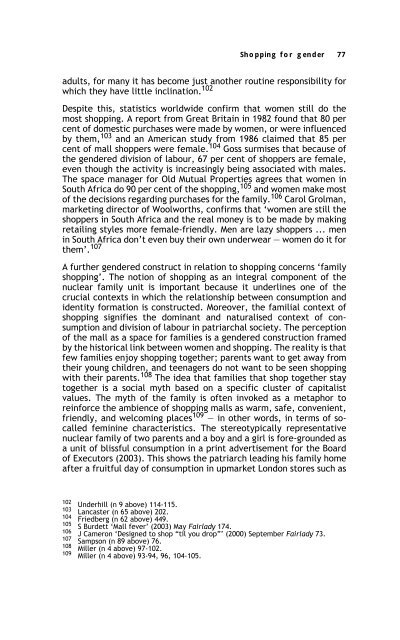Sex, Gender, Becoming - PULP
Sex, Gender, Becoming - PULP
Sex, Gender, Becoming - PULP
You also want an ePaper? Increase the reach of your titles
YUMPU automatically turns print PDFs into web optimized ePapers that Google loves.
Shopping for gender 77<br />
adults, for many it has become just another routine responsibility for<br />
which they have little inclination. 102<br />
Despite this, statistics worldwide confirm that women still do the<br />
most shopping. A report from Great Britain in 1982 found that 80 per<br />
cent of domestic purchases were made by women, or were influenced<br />
by them, 103 and an American study from 1986 claimed that 85 per<br />
cent of mall shoppers were female. 104 Goss surmises that because of<br />
the gendered division of labour, 67 per cent of shoppers are female,<br />
even though the activity is increasingly being associated with males.<br />
The space manager for Old Mutual Properties agrees that women in<br />
South Africa do 90 per cent of the shopping, 105 and women make most<br />
of the decisions regarding purchases for the family. 106 Carol Grolman,<br />
marketing director of Woolworths, confirms that ‘women are still the<br />
shoppers in South Africa and the real money is to be made by making<br />
retailing styles more female-friendly. Men are lazy shoppers ... men<br />
in South Africa don’t even buy their own underwear — women do it for<br />
them’. 107<br />
A further gendered construct in relation to shopping concerns ‘family<br />
shopping’. The notion of shopping as an integral component of the<br />
nuclear family unit is important because it underlines one of the<br />
crucial contexts in which the relationship between consumption and<br />
identity formation is constructed. Moreover, the familial context of<br />
shopping signifies the dominant and naturalised context of consumption<br />
and division of labour in patriarchal society. The perception<br />
of the mall as a space for families is a gendered construction framed<br />
by the historical link between women and shopping. The reality is that<br />
few families enjoy shopping together; parents want to get away from<br />
their young children, and teenagers do not want to be seen shopping<br />
with their parents. 108 The idea that families that shop together stay<br />
together is a social myth based on a specific cluster of capitalist<br />
values. The myth of the family is often invoked as a metaphor to<br />
reinforce the ambience of shopping malls as warm, safe, convenient,<br />
friendly, and welcoming places 109 — in other words, in terms of socalled<br />
feminine characteristics. The stereotypically representative<br />
nuclear family of two parents and a boy and a girl is fore-grounded as<br />
a unit of blissful consumption in a print advertisement for the Board<br />
of Executors (2003). This shows the patriarch leading his family home<br />
after a fruitful day of consumption in upmarket London stores such as<br />
102<br />
Underhill (n 9 above) 114-115.<br />
103 Lancaster (n 65 above) 202.<br />
104 Friedberg (n 62 above) 449.<br />
105<br />
S Burdett ‘Mall fever’ (2003) May Fairlady 174.<br />
106 J Cameron ‘Designed to shop “til you drop”’ (2000) September Fairlady 73.<br />
107 Sampson (n 89 above) 76.<br />
108<br />
Miller (n 4 above) 97-102.<br />
109 Miller (n 4 above) 93-94, 96, 104-105.
















